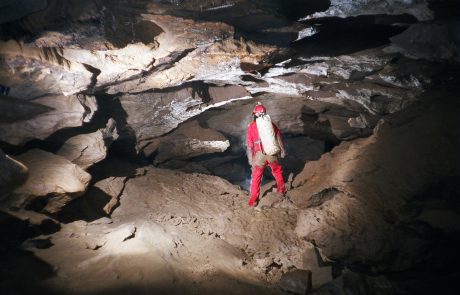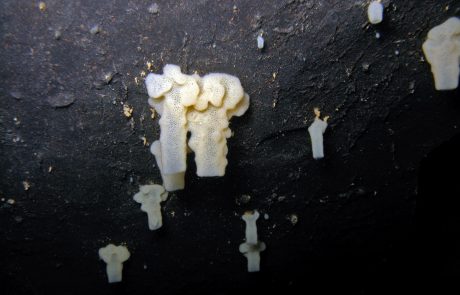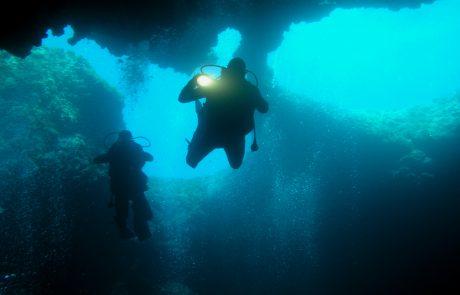
Terrestrial habitats
Cave habitats share some common features:
- lack of light, with the exception of cave entrances,
- relatively small amount of food, which all comes from outside of the caves and is brought in by sinking rivers and percolating water, by different animals (e.g. bats), as well as by falling in the caves,
- relative humidity is very high and stabile, and depends on the air flow and circulation in caves,
- relatively stable air temperature which usually matches the annual average temperature of the cave area, but also depends on the morphology, hydrology and proportions of the cave, and relatively stable water temperature.
According to National Habitat Classification of Croatia, underground habitats are classified in four main habitat types:
- Caves in karst (limestone caves),
- Caves in other substrate than karst (non-limestone caves),
- Interstitial subterranean habitats, and
- Artificial subterranean habitats.
Compared to other habitat types, the H.1. Caves in karst habitat type is the most abundant, the most diversified and inhabited by the greatest number of species.
According to the media in which cave organisms live, cave habitats can be divided in the terrestrial, transitional and aquatic habitats.
Terrestrial habitats
Terrestrial habitats in caves are inhabited by many different species, depending on the characteristics of substrate and their position of habitats.
In cave entrances we usually find trogloxenes and troglophiles on walls and rocks, in sediment, between and under rocks and on the organic matter. These parts of the caves are inhabited by many species of harvestmans, centipedes, grasshoppers, springtails, woodlice and other groups. These cave entrances are rich in organic matter and sometimes can be attractive to inhabitants of the deeper parts of the caves which come there for hunting or feeding.
In deeper parts of the caves, troglobionts are adapted to less amount of food, complete darkness and stabile temperature. Many species of cave beetles, false scorpions, woodlices, spiders, springtails and other groups can be found in deeper parts.
Some of these animals live on the ground, between and under rocks, where they feed on small parts of organic matter or hunt their prey. Other species can be found mostly on walls, cave speleothemes, and in wall cracks where they feed on small organic particles which are brought by water or they knit nets and hunt prey. Places with large amounts of bats or birds guano are special habitat in caves. Huge density of guanophile organisms which feed on guano or fungi and bacteria that grows on guano can be found on such places. These places are especially interesting for many predators as well.
Cave hygropetric
Somewhere in between terrestrial and aquatic habitat there is a special habitat of cave hygropetric. Cave hygropetric is a place on cave walls where thin layer of water permanently flows. In such habitat, special cave beetles like those from genera Radziella, Croatodirus, Velebitodromus and Hadesia can be found. They developed special mouth structures that help them to filtrate small organic matters from the water. Interesting cave leech Croatobranchus mestrovi, which is on the logo of the Croatian Biospeleological Society, is also an inhabitant of cave hygropetric.
Cave hygropetric is usually far away from the cave entrances and very often very deep in pits. Consequently, it is very poorly explored and is probably inhabited by new and undiscovered species.
Aquatic habitats
Aquatic habitats can be divided according to the type of sediment, water velocity and water quantity.
Very few species are adapted to strong streams of water in caves. In more peaceful environment, like some small pools or stagnant water, more species can be found e.g. the ones from genera Niphargus, Troglocaris, Monolistra and Proasellus. Stagnant waters can be huge underground lakes or some small occasional puddles in clay sediment.
Sinter pools are special habitat where some of the interstitial animals can be found, probably brought from their habitat by percolating water.
Special habitat of aquatic animals is the community of marifugical layers. The basis of this community are calcite tubes of polychaete Marifugia cavatica, where numerous other aquatic animals find their shelter and food.
Some of the most famous groundwater animals like the olm (Proteus anguinus), cave clams (Congeria spp.) and ogulin cave sponge (Eunapius subterraneus) live in Croatian underground waters. Some sessile animals, like Marifugia cavatica and Congeria spp., have adapted to the unstable environment and can survive longer periods out of the water during low levels of groundwater.
BIBLIOGRAPHY
- Gottstein Matočec, S., Ozimec, R., Jalžić, B., Kerovec, M. & Bakran-Petricioli, T. (2002): Raznolikost i ugroženost podzemne faune Hrvatske. Ministarstvo zaštite okoliša i prostornog uređenja, Zagreb. pp. 82.
- Gottstein, S. (2010): Priručnik za određivanje podzemnih staništa u Hrvatskoj prema Direktivi o staništima EU. Državni zavod za zaštitu prirode, Zagreb. pp. 99.
- White, W. B. & Culver, D. C. (2012): Encyclopedia of Caves, 2nd Edition. Academic Press, Oxford. pp 966.










